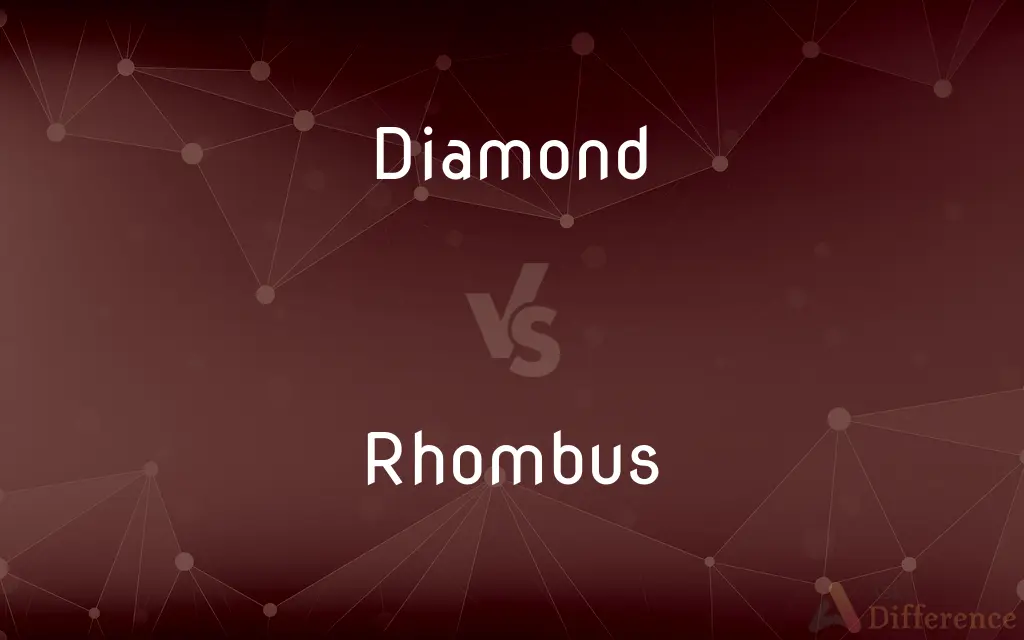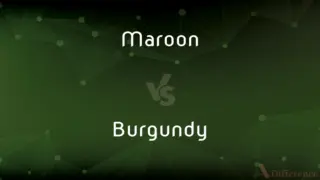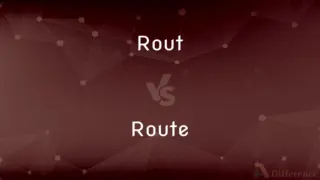Diamond vs. Rhombus — What's the Difference?
By Tayyaba Rehman & Fiza Rafique — Updated on September 10, 2023
A diamond is a precious gemstone formed under extreme pressure and heat, or a quadrilateral with equal sides and two pairs of parallel sides but not necessarily equal angles. A rhombus is a quadrilateral with all sides equal in length and opposite angles.

Difference Between Diamond and Rhombus
Table of Contents
ADVERTISEMENT
Key Differences
A diamond can refer to either a precious gemstone or a geometric shape. The gemstone is a form of carbon that has been subjected to extreme pressure and heat over a long period. A rhombus, however, exclusively refers to a geometric shape, a type of quadrilateral where all sides are equal in length and opposite angles are equal. While a geometric diamond and a rhombus share the property of having equal-length sides, they differ in their internal angles and connotations.
In the world of gemstones, diamonds are known for their brilliance, hardness, and high market value. They are commonly used in jewelry and are considered a symbol of love and commitment. Rhombuses don't have a place in this context as they are strictly a geometric term, unassociated with the emotional or monetary value that diamonds can carry.
In geometry, a diamond generally refers to a four-sided shape, also known as a quadrilateral, with sides of equal length but not necessarily with angles of equal measure. A rhombus is a more specific term in geometry: it not only has sides of equal length but also opposite angles of equal measure. Therefore, all rhombuses are diamonds, but not all diamonds are rhombuses.
Another difference between diamonds and rhombuses lies in their symbolic meanings outside of geometry and gemology. The term "diamond" is often used in various fields like baseball, playing cards, and even in business as a symbol of quality or a specific arrangement. A rhombus doesn't have such broad symbolic interpretations and is largely confined to mathematical contexts.
Comparison Chart
Definition
Gemstone or quadrilateral
Geometric shape
ADVERTISEMENT
Sides
Equal-length
Equal-length
Angles
Not necessarily equal
Opposite angles are equal
Symbolic Meaning
Varies
Mostly mathematical
Associated Fields
Gemology, various others
Geometry
Compare with Definitions
Diamond
A precious stone consisting of a clear and colorless crystalline form of pure carbon.
The diamond ring sparkled brilliantly.
Rhombus
A quadrilateral with four sides of equal length and opposite angles of equal measure.
A square is a special case of a rhombus.
Diamond
A quadrilateral with four equal sides but not necessarily equal angles.
In geometry class, we studied the properties of a diamond shape.
Rhombus
A parallelogram with all sides equal.
The rhombus has two sets of parallel sides.
Diamond
A symbol of wealth, quality, or rarity.
The diamond certification guarantees its value.
Rhombus
A shape commonly studied in elementary geometry.
We learned about the properties of a rhombus today.
Diamond
A playing card suit.
I have three diamonds in my hand.
Rhombus
A specific form of a diamond in geometry.
Not all diamonds are rhombuses, but all rhombuses are diamonds.
Diamond
The layout or field in baseball.
The team took their positions on the diamond.
Rhombus
A geometric shape often used in tiling patterns.
The floor was covered in a pattern of rhombuses.
Diamond
Diamond is a form of the element carbon with its atoms arranged in a crystal structure called diamond cubic. At room temperature and pressure, another solid form of carbon known as graphite is the chemically stable form of carbon, but diamond almost never converts to it.
Rhombus
In plane Euclidean geometry, a rhombus (plural rhombi or rhombuses) is a quadrilateral whose four sides all have the same length. Another name is equilateral quadrilateral, since equilateral means that all of its sides are equal in length.
Diamond
A precious stone consisting of a clear and colourless crystalline form of pure carbon, the hardest naturally occurring substance
A diamond ring
Rhombus
A quadrilateral all of whose sides have the same length.
Diamond
A figure with four straight sides of equal length forming two opposite acute angles and two opposite obtuse angles; a rhombus
A sweater with a pale-blue diamond pattern
Rhombus
An equilateral parallelogram, especially one having oblique angles. Also called rhomb.
Diamond
An extremely hard, highly refractive crystalline form of carbon that is usually colorless and is used as a gemstone and in abrasives, cutting tools, and other applications.
Rhombus
(geometry) A parallelogram having all sides of equal length.
Diamond
A piece of jewelry containing such a gemstone.
Rhombus
The rhombus diamond, as one of the suits seen in a deck of playing cards (♦ or ♦).
Diamond
A rhombus, particularly when oriented so that one diagonal extends from left to right and the other diagonal extends from top to bottom.
Rhombus
In early Greek religion, an instrument whirled on the end of a string similar to a bullroarer.
Diamond
A red, lozenge-shaped figure on certain playing cards.
Rhombus
Any of several flatfishes, including the brill and turbot, once considered part of the genus Rhombus, now in Scophthalmus.
Diamond
A playing card with this figure.
Rhombus
Snails, now in genus Conus or family Conidae.
Diamond
Diamonds (used with a sing. or pl. verb) The suit of cards represented by this figure.
Rhombus
Same as Rhomb, 1.
Diamond
The infield.
Rhombus
A parallelogram with four equal sides; an oblique-angled equilateral parallelogram
Diamond
The whole playing field.
Diamond
Of or relating to a 60th or 75th anniversary.
Diamond
To adorn with diamonds.
Diamond
(uncountable) A glimmering glass-like mineral that is an allotrope of carbon in which each atom is surrounded by four others in the form of a tetrahedron. Category:en:Carbon
The saw is coated with diamond.
Diamond
A gemstone made from this mineral.
The dozen loose diamonds sparkled in the light.
Diamond
A ring containing a diamond.
What a beautiful engagement diamond.
Diamond
A very pale blue color.
Diamond
Something that resembles a diamond.
Diamond
(geometry) A rhombus, especially when oriented so that its longer axis is vertical.
Diamond
(geometry) The polyiamond made up of two triangles.
Diamond
(baseball) The entire field of play used in the game.
Diamond
(baseball) The infield of a baseball field.
The teams met on the diamond.
Diamond
(card games) A card of the diamonds suit.
I have only one diamond in my hand.
Diamond
A size of type, standardised as 2 point.
Diamond
The size of type between brilliant and pearl, standardized as 2-point.
Diamond
Made of, or containing diamond, a diamond or diamonds.
He gave her diamond earrings.
Diamond
Of, relating to, or being a sixtieth anniversary.
Today is their diamond wedding anniversary.
Diamond
Of, relating to, or being a seventy-fifth anniversary.
Today is their diamond wedding anniversary.
Diamond
(slang) First-rate; excellent.
He's a diamond geezer.
Diamond
To adorn with or as if with diamonds
Diamond
A precious stone or gem excelling in brilliancy and beautiful play of prismatic colors, and remarkable for extreme hardness.
Diamond
A geometrical figure, consisting of four equal straight lines, and having two of the interior angles acute and two obtuse; a rhombus; a lozenge.
Diamond
One of a suit of playing cards, stamped with the figure of a diamond.
Diamond
A pointed projection, like a four-sided pyramid, used for ornament in lines or groups.
Diamond
The infield; the square space, 90 feet on a side, having the bases at its angles.
Diamond
The smallest kind of type in English printing, except that called brilliant, which is seldom seen.
Diamond
Resembling a diamond; made of, or abounding in, diamonds; as, a diamond chain; a diamond field.
Diamond
A transparent piece of diamond that has been cut and polished and is valued as a precious gem
Diamond
Very hard native crystalline carbon valued as a gem
Diamond
A playing card in the minor suit of diamonds
Diamond
The area of a baseball field that is enclosed by 3 bases and home plate
Diamond
The baseball playing field
Common Curiosities
What is a diamond?
A diamond can either be a precious gemstone or a quadrilateral with equal-length sides.
Are all diamonds rhombuses?
No, not all diamonds are rhombuses.
Do diamonds and rhombuses have equal-length sides?
Yes, both have sides of equal length.
What is the symbolic meaning of a diamond?
Diamonds can symbolize love, quality, or rarity.
Does a rhombus have symbolic meaning?
Generally, a rhombus is confined to mathematical contexts and lacks broader symbolic meaning.
What is a rhombus?
A rhombus is a quadrilateral with all sides equal in length and opposite angles equal.
Is a diamond always a precious stone?
No, the term can also refer to a geometric shape.
Is a rhombus always a geometric shape?
Yes, a rhombus is strictly a geometric term.
What fields are associated with diamonds?
Gemology, baseball, playing cards, and various others.
Are all rhombuses diamonds?
Yes, all rhombuses are considered diamonds in geometry.
Do diamonds and rhombuses have equal angles?
Rhombuses have opposite equal angles, but diamonds do not necessarily have equal angles.
What fields are associated with rhombuses?
Mainly geometry and design.
Where are diamonds commonly used?
Diamonds are commonly used in jewelry, industrial cutting, and as a symbol in various fields.
Where is the term rhombus commonly used?
The term rhombus is mainly used in geometry and design.
Is a square a diamond or a rhombus?
A square is both a diamond and a rhombus with equal angles and sides.
Share Your Discovery

Previous Comparison
Maroon vs. Burgundy
Next Comparison
Rout vs. RouteAuthor Spotlight
Written by
Tayyaba RehmanTayyaba Rehman is a distinguished writer, currently serving as a primary contributor to askdifference.com. As a researcher in semantics and etymology, Tayyaba's passion for the complexity of languages and their distinctions has found a perfect home on the platform. Tayyaba delves into the intricacies of language, distinguishing between commonly confused words and phrases, thereby providing clarity for readers worldwide.
Co-written by
Fiza RafiqueFiza Rafique is a skilled content writer at AskDifference.com, where she meticulously refines and enhances written pieces. Drawing from her vast editorial expertise, Fiza ensures clarity, accuracy, and precision in every article. Passionate about language, she continually seeks to elevate the quality of content for readers worldwide.













































